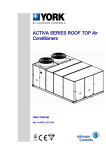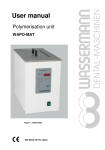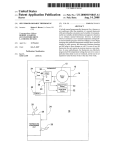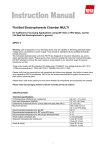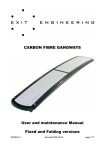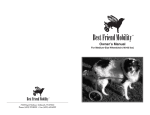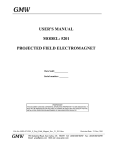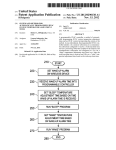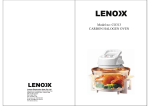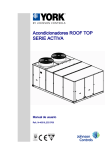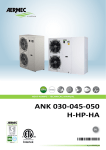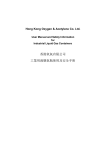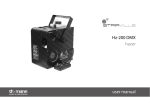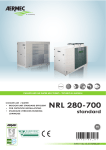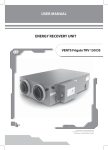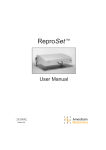Download VITALITY Axial Large Split VAC-VAH 20 to 90 A
Transcript
VITALITY LARGE SPLIT AIR ‑ AIR Air conditionating units User manual Ref.: N-40340_EN 0210 Index Index 1 User manual............................................................................................................................ 1 1.1 1.1.1 1.1.2 1.1.3 1.1.4 1.1.5 General description of the unit .............................................................................................. Operating diagram.................................................................................................................. Parts of the VITALITY............................................................................................................ Description of the unit............................................................................................................. YKN2 Open Control Circuit.................................................................................................... Service and Maintenance Access.......................................................................................... 1.2 1.3 1.4 1.4.1 1.4.2 1.4.3 1.5 1.5.1 1.5.2 1.6 1.7 1.7.1 1.7.2 1.7.3 1.7.4 1.7.5 1.8 1.8.1 1.8.2 Intended use of the unit.......................................................................................................... 6 Description of the unit's main control panel............................................................................ 7 Modes of operation................................................................................................................ 7 VAC models: air conditioning................................................................................................. 7 VAH models: heat pump........................................................................................................ 7 General instructions............................................................................................................... 8 Operating instructions............................................................................................................ 8 Thermostat connections to the control board......................................................................... 8 Thermostat connections......................................................................................................... 9 Safety and equipment protection systems............................................................................. 9 Placing the unit out of service for planned stoppage or malfunction ................................... 10 Placing the unit out of service for planned stoppage............................................................ 10 Placing the unit out of service for seasonal stoppage.......................................................... 10 Placing the unit out of service due to a fault......................................................................... 10 Fault codes for the air conditioning unit................................................................................ 10 Restarting the air conditioning unit in the case of breakdown.............................................. 11 Regular maintenance by the user ....................................................................................... 11 Maintenance Schedule......................................................................................................... 11 Maintenance responsibilities of the user.............................................................................. 12 2 2 2 4 6 6 i 1 User manual 1 1.1 User manual General description of the unit 1.1 General description of the unit 1.1.1 Operating diagram 1. Indoor unit A. Air from indoors 2. Outdoor unit B. Air to indoors 3. Fan 4. Axial fan C. 5. Filter Possibility of air to vertical indoors (optional) 6. Coil D. Air to outdoors E. Air from outdoors 7. Optional: water coil, electric resis‐ tor, etc. 8. Compressor 1.1.2 Parts of the VITALITY The VITALITY series range is made up of a series of air ‑ air units with centrifugal fans in the indoor unit and axial fans in the outdoor unit. The outdoor unit includes: • • • • Compressor. Condenser. Axial fan. Controls and DPC-1 thermostat. The VIR indoor unit includes: • • • 2 Evaporator coil. Air filter. Centrifugal fan. User manual General description of the unit 1 1.1 The unit can be located indoors or outdoors, as it is protected to withstand outdoor weather conditions. The units is supplied fully fitted and factory-tested and is designed to provide a significant saving of energy and a long working life. The air intakes and outlets on each VIR model can be configured vertically or horizontally (using the optional kit). Software installed on the YKN2 Open electronic board provides electronic management for the YKN2 Open control board. In addition, a wide range of accessories is available to adapt the units to the specific requirements of each application. The VITALITY series air conditioning units can be used in extreme weather conditions. 3 1 1.1 User manual General description of the unit 1.1.3 Description of the unit Compressors type compressors with internal motor protection and external sump resistor included as standard, which keeps the oil hot for easier start-up and to prevent its drag outside the compressor. They are charged with a POE (polyol-ester) oil to avoid the formation of foam. VAC-VAH 20A, 25A, 30A and 40A units have just one compressor and VAC-VAH 45A, 60A, 75A and 90A units have two compressors with two independent circuits. The compressors have been specifically designed for units with heat pumps: their mechanical compo‐ nents are large and their motors have a lower current consumption. The compressors have dampers to reduce operating noise and vibrations. Based on the accumulated operating hours of each compressor, a control circuit determines the order of operation, thus lengthening their working life. Suction accumulator (models with heat pump only) Connected to the compressor suction pipe, this protects it from hammering by liquid. Coils These are large and made of copper tubes and aluminium fins. They are located inside the unit, protected against knocks during transportation and installation. To adapt the product perfectly to its environment, there are options such as coils with Blue-Fintype fins or copper fins. Indoor fan (on VIR 25A model only) A centrifugal fan driven by an independent motor and with belt transmission is installed in the VIR 25A model. Indoor fan (models VIR 40A, 45A, 60A, 75A and 90A) One, two or four centrifugal fans with a joint shaft, driven by an independent motor and connected to a single plenum are installed in the models indicated. Outdoor fan (VAC-VAH models) One, two or four axial fans with free discharge, no ducts and low operating noise levels are installed in the models indicated. Optionally, a summer cycle operating speed adjuster can be fitted that is adjusted by the high pressure of the cooling circuit. Cooling circuit The cooling circuit is made of welded copper pipes and includes access connections on the high and low-pressure sides. It is fitted with shut off valves on the suction side that are used in the factory to protect the compressor during the 45 bar pressure test that all units must pass. The VAC-VAH and VIR units are supplied with pre-connections for welding. Refrigerant The gas refrigerant must be fully charged during on-site installation. The entire range of units uses environment-friendly, recyclable R-410A gas refrigerant. Cooling circuit protection All cooling circuits are supplied as standard with high and low-pressure switches, dehydrator filter on the liquid line, discharge temperature cut-out switch, liquid sight glasses and temperature sensors for supply air, suction liquid and outdoor air. 4 User manual General description of the unit 1 1.1 Electrical panel The electrical panel is directly accessible from the outside by means of a panel with 1/4 turn closures. It includes a connection terminal strip, protectors, electronic boards and sensors, power contactors, switch‐ ing relays, phase control relay and transfer for the 24V control circuit. The electrical panel for the unit has an IP44 level of protection and is compliant with current European regulations. Sequence and phase fault sensor relay The unit is fitted with a sequence and phase fault sensor: where a non R-S-T phase sequence is detected or where, once the unit is running, there is a phase fault, the sensor will disconnect the power supply to the main board of the unit, preventing it from starting. Construction and rust protection features All metal parts of the structure are made of galvanised aluminium steel plate. The outdoor parts are treated with oven-polymerised polyester paint (RAL9002), guaranteeing a quality finish that lasts for many years (800 H.N.S. according to DIN 50021). Unit base (VAC-VAH models) The base of the unit is made with fixed beams that provide a solid foundation. Openings on the front of these beams can be used to attach a crane for hoisting the unit into position during the installation process. The beams also have openings on the bottom to place the unit on dampers, if required. Service connections For easier electricity connections with a minimal amount of work, electrical and control cables can be pulled through the front of the unit. Noise emissions All units operate with extremely low noise emission levels. The compressors have anti-vibration mounts as well as vertical discharge fans that direct noise upwards, away from surrounding buildings and prop‐ erty. Thermal/Acoustic Insulation The inside of the evaporator area and the heating supply/accessory area are fully insulated. The insu‐ lation is 5 mm thick. Indoor electric resistors (Optional) Exposed cord-type for fast heat dissipation, avoiding temperature inertia that could affect the compo‐ nents. 5 1 1.2 User manual Intended use of the unit 1.1.4 YKN2 Open Control Circuit YKN2 Open YKN2 Open control board The control circuit is 24 V and can operate with the standard DPC-1 thermostat (communication) or with a 24 V thermostat with control signals (Y1, G, O/B, W). A YKtoolsystem analyser can be used for easier startup and to locate and solve any installation or operat‐ ing faults. 1.1.5 Service and Maintenance Access The units are fitted with access panels with 1/4 turn closures on the control panel and levers offering fast, safe access to all components requiring service or maintenance. Access to the control circuit is independent to the cooling system of the unit. The unit is fitted with connections for specific manometers for easier reading of cooling circuit pressures. 1.2 Intended use of the unit The VITALITY series of units is exclusively designed for the air conditioning of buildings and properties. Therefore, the unit has a cold generating system, a heat pump and, as optional, auxiliary electrical re‐ sistors and hot water coil. Depending on the version that forces air to circulate through ducts to adjust the temperature of the building or property where it is installed. The air conditioning unit has a start-up and setting mechanism (by means of a thermostat) to manage its operations. The unit should only be used for the purposes for which it was designed and built. Johnson Controls Inc. shall not be considered responsible for any damage caused by inappropriate use or maintenance of the unit that is any way inconsistent with that described in this document or others specifically provided with the unit. Any use other than air conditioning will be considered inconsistent. 6 User manual Description of the unit's main control panel 1 1.3 1.3 Description of the unit's main control panel The main control panel is found on the unit itself and is protected from the outside by a removable metal panel. 1 Connection entry. 2 Grommet support tray. Given that the air conditioning unit is installed on the roof of a building or property, users must under no circumstances inspect or adjust the unit themselves. All of inspections or adjustments that may be made by the user are performed using the DPC-1 thermo‐ stat. If the air conditioning unit is faulty, its self-diagnostics system will identify the source and the pilot light -1on the display of the DPC-1 thermostat will switch on. The display will also show a two-digit number on the lower left -2-, indicating the effected component. See Placing the unit out of service due to a fault , see on page 10 . If the thermostat display keeps showing the pilot light -1- and any fault code or if the air conditioner does not start, contact a Johnson Controls Inc. Authorised Technical Assistance Service. 1.4 Modes of operation The VITALITY range of air conditioning units includes different models: the operating mode for each one varies depending on the specific model. 1.4.1 VAC models: air conditioning The VAC model circulates gas refrigerant (R-410A) through a cooling circuit driven by two compressors (depending on models). The propelled gas circulates through an evaporator coil where it absorbs ambient heat and evaporates. To liquefy the evaporated gas, it is then circulated through a condenser coil where it releases the previously absorbed heat into the atmosphere. To favour the evaporation and condensation of the gas refrigerant, the unit has supply and intake fans that force the air through each of the coils. In the case of the evaporator, the fan pushes air to the inside of the building or property through previously-installed distribution ducts. In the case of the condenser, the fan pushes fresh air through the coil and then sends it back outdoors. A series of filters remove dust particles and pollen, etc. from the air sent inside the building or property. 1.4.2 VAH models: heat pump The VAH models operate the same way as the VAC units, although they can also reverse the cooling circuit operation so that the coils exchange functions and send warm air to the inside of the building or property and the cold air outdoors. 7 1 1.5 User manual Operating instructions 1.4.3 General instructions CAUTION Always keep the electrical power supply connected to the unit. Only disconnect the unit if it is not to be used for a long period of time. When preparing for seasonal use, connect the unit to the electricity supply at least 8 hours before starting it. • • • False start the compressors (connect them just long enough to make a few turns). To do so, use contactors -KM1- and -KM2-. Wait for 5 to 7 minutes and repeat the false start. Wait another 5 to 7 minutes and perform a last false start. Then switch the compressors to full working order. 1.5 Operating instructions A thermostat is used for starting and managing the air conditioning unit and for adjusting the temperature of the supply air. Through this thermostat, the operating programme determines when to automatically start the air con‐ ditioning unit. The performance of the different unit components is also determined by the operating programme. See the documents on the DPC-1 programmable digital thermostat with communication or the documents on the thermostat installed with the unit for further details on the start-up and adjustment mechanism. 1.5.1 Thermostat connections to the control board A. Thermostat connection board. Board connection terminals X1. To terminal X1 of the DPC-1 thermostat. B. White To terminal B of the DPC-1 thermostat. R. Red. To terminal R of the DPC-1 thermostat. W. – O/B – Y1 8 – User manual Safety and equipment protection systems 1 1.6 1.5.2 Thermostat connections 1. Yellow cable. 2. Red cable. 3. White cable. A. Shielded cable, 2 x 0.5 mm2. Maximum length: 100 m. B. Shielded cable, 10 x 0.22 mm2. Maximum length: 100 m. 1.6 Safety and equipment protection systems The VITALITY range of air conditioning units includes an entire series of safety and protection systems intended to provide a high degree of safety for users and maintenance personnel. Those not expressly authorised to use the air conditioning unit must not handle it or perform repair or maintenance work. Safety systems Johnson Controls Inc. manufactures air conditioning units in accordance with EU occupational protection and user safety regulations, provided that the units are used and maintained in line with the instructions and indications given in this document. Given that the air conditioning unit is installed on the roof of a building or property, users must under no circumstances inspect or adjust the unit themselves. All of inspections or adjustments that may be made by the user are performed using the DPC-1 thermostat. The air conditioning unit is fitted with electrical protection systems to protect personnel responsible for its regular maintenance and upkeep. As established by applicable electricity regulations, the electrical system is fitted with electricity surge and current leakage protection system consisting of differential circuit breakers and thermal magnetic switches (not supplied by the manufacturer, must be installed on site). Under no circumstances is the user of the air conditioning unit exposed to live parts. Likewise, access to moving parts by unauthorised persons is prevented. This involves placing appropri‐ ate safety locks on all of the removable covers on the unit. Unit protection systems The refrigerant circuit of the unit is protected against excessively high or low pressure and discharge temperature. It is also protected against repeated cold start-ups caused by the compressor intake sensor when the summer cycle is activated. 9 1 1.7 User manual Placing the unit out of service for planned stoppage or malfunction 1.7 Placing the unit out of service for planned stoppage or mal‐ function 1.7.1 Placing the unit out of service for planned stoppage To stop the air conditioning unit using the DPC-1 ther‐ mostat, press the MODE, -1- key repeatedly until the following appears: OFF, -2-. 1.7.2 Placing the unit out of service for seasonal stoppage The power supply to the unit must be disconnected when placing the air conditioning unit out of service for long periods of time (seasonal stoppage). To do so, the differential circuit breaker and thermal magnetic switch on the unit power supply must be disconnected. • • • CAUTION Always keep the electrical power supply connected to the unit. Only disconnect the unit if it is not to be used for a long period of time. When preparing for seasonal use, connect the unit to the electricity supply at least 8 hours before starting it. 1.7.3 Placing the unit out of service due to a fault If the air conditioning unit is faulty, its self-diagnostics system will identify the source and the pilot light -1on the display of the DPC-1 thermostat will switch on. The display will also show a two-digit number on the lower left -2-indicating the effected component. 1.7.4 Fault codes for the air conditioning unit Code 10 Description 11 / 21 / 31 Discharge temperature exceeded 12 / 22 / 32 High-pressure switch, outdoor fan thermal switch or compressor module ther‐ mal switch (depending on model) User manual Regular maintenance by the user Code 13 / 23 / 33 14 15 / 25 / 35 • • 1 1.8 Description Low pressure switch Indoor fan thermal switch Repeated cold start-up or suction temperature < ‑25 °C 41 Gas control 1 or resistor 1 fault 42 Gas control 2 or resistor 2 fault 43 Resistor stage 3 fault 44 Resistor stage 4 fault 45 Fault in economiser or hot water coil (outdoor supply, water return sensor) 46 Smoke detector, high temperature, or supply temperature >80 ºC 91 Ambient sensor open or short circuited 92 Internal sensor not calibrated 93 Communication error 94 fault with AL terminal connected 95 S5 digital sensor not detected 96 S6 digital sensor not detected 97 S7 digital sensor not detected 98 S8 digital sensor not detected 99 Digital outdoor sensor not detected NOTE The fault pilot light on the DPC-1 thermostat display will flash if a fault code between 0 and 90 is shown. The fault pilot light on the DPC-1 thermostat display will also flash if fault code 93 is shown. 1.7.5 Restarting the air conditioning unit in the case of breakdown If you have to restart the unit it is possible by pressing the MODE key on the thermostat repeatedly until the display indicates OFF. Then, restart the unit by pressing the MODE key and select the required operating mode. The unit will start up normally if the cause of the fault is no longer present. If the cause persists, it is possible to start the unit a maximum of three times within a 24-hour period. If the thermostat display keeps showing the pilot light -1- and any fault code or if the air conditioner does not start, contact a Johnson Controls Inc. Authorised Technical Assistance Service. 1.8 Regular maintenance by the user 1.8.1 Maintenance Schedule The air conditioning unit is designed to require as little maintenance as possible. Nevertheless, to ensure smooth operations with a minimal use of electricity, a long working life and compliance with the regula‐ tions of each country, regular maintenance inspections must be made. Johnson Controls Inc. shall not be considered responsible for any damage caused by improper mainte‐ nance of the unit, which includes anything inconsistent with that described in this document or others specifically provided with the unit. To make them easier, maintenance tasks have been grouped by time intervals in a series of tables. Maintenance responsibilities of the user , see on page 12 . 11 1 1.8 User manual Regular maintenance by the user 1.8.2 Maintenance responsibilities of the user Like any other machine, the air conditioning unit requires regular maintenance, as the wear to which some of its parts are subjected can effect its mechanical reliability and the safety of those responsible for its maintenance. In compliance with current regulations, the unit must be regularly inspected and the results recorded on the forms provided by the Labour and Health Authorities of the country where the air conditioning unit is installed. Users cannot access this form to perform maintenance and upkeep tasks on the unit. There is no intent for the user to perform any maintenance tasks on the air conditioning unit. DANGER It is strictly prohibited for the user to carry out any maintenance or upkeep tasks on the air conditioning unit. Only trained Johnson Controls Inc. personnel with the necessary means and tools may carry out main‐ tenance and upkeep work on the unit. Trained personnel must be aware of the health and safety regulations and procedures applicable to air conditioning units. They should also be aware of general procedures and those applying specifically to this unit. Contact a Johnson Controls Inc. Authorised Technical Assistance Service for scheduled maintenance on this unit. To discover the maintenance operations a Johnson Controls Inc. Authorised Technical Assistance Serv‐ ice should regularly perform, see Maintenance Schedule , see on page 11 . PRODUCT DISPOSAL According to Directive 2002/96/EC of the European Parliament and of the Council of 27 January 2003, the presence of the symbol on the product or in the docu‐ ments included with the product indicates that this product is classified, according to current law, as an electrical and electronic device and, therefore, this product cannot be dealt with at the end of its working life as domestic or urban waste. The product must be taken to collection points for the recycling of waste electrical and electronic equip‐ ment. The appropriate management, reuse, assessment and recycling of these products protect human health and the environment. 12















